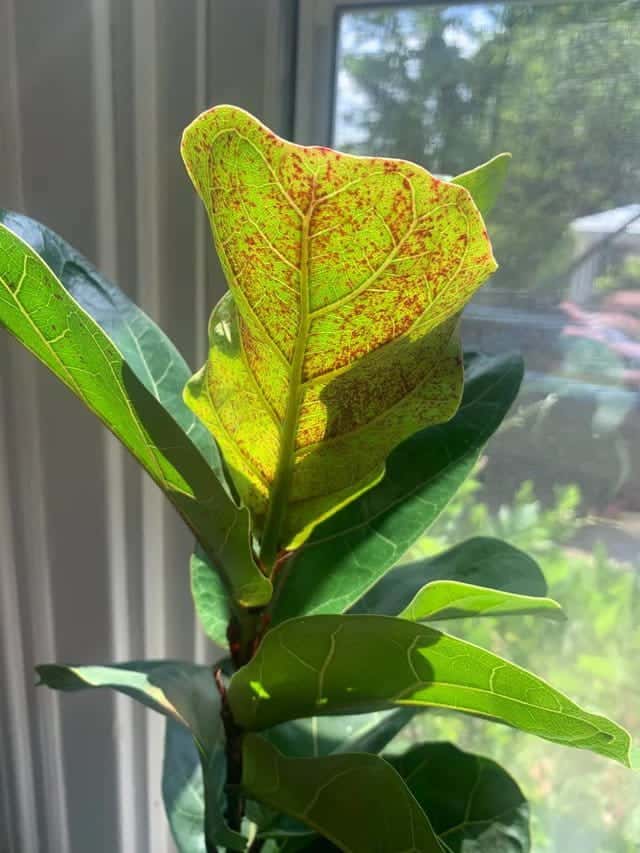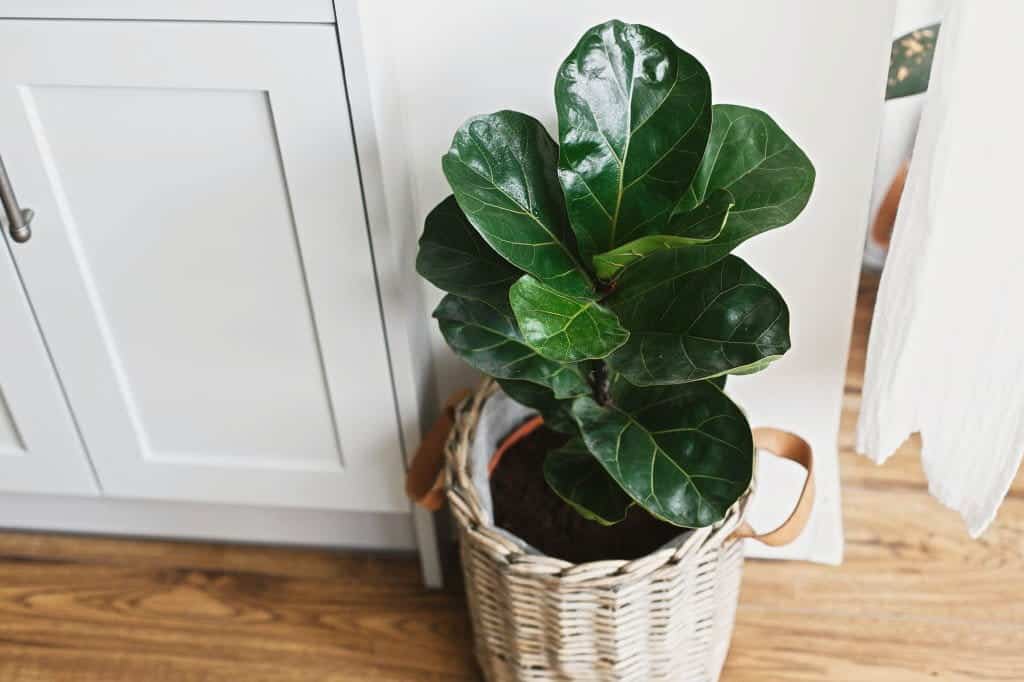Red spots on fiddle leaf fig? – the reasons you need to know
Fiddle Leaf Fig is a well-known plant that is popular for home decoration, bringing modern and luxurious beauty to the space and making it more lively and eye-catching. Ficus Lyrata is the scientific name for Fiddle Leaf Fig, which belongs to the mulberry family.
The leaves are green, the leaf blade is broad and long, and the veins on the back are prominent. A soft hairy layer covers the young leaves as well. So when fresh young leaves appear from the top of your plant, you may feel ecstatic.
When healthy, Fiddle Leaf Fig is green, but sometimes red spots appear that worry the gardener. Is this a disease of the tree? Let’s find out the reason through the article below.

Reasons why red spots on fiddle leaf fig and how to fix them
There are many reasons why the fiddle leaf fig has red spots. Let’s take a look at the following reasons.
1. Unbalanced moisture
Edema is a physiological disorder in which affected plants’ leaves develop little red bumps or pockmarks. Moisture stress or an imbalance in the leaf cells causes it to happen. The younger leaves of fiddle leaf figs frequently have more edema.
Fiddle leaf fig leaf cells can sometimes absorb water quicker than they can discharge it from the roots. This is more likely to happen when the soil is overwatered. As the blisters swell, the water-soaked leaf cells burst, and the plant tissue surrounding the blisters turns red as the wound heals.
The beginning of edema is aided by planting Ficus Lyrata in a pot with poor drainage or a compact soil mix with poor drainage/aeration. Because water is kept near the roots of the plant for longer in these conditions, the roots absorb moisture more quickly.
How to fix
Take note of the plant’s growth cycle if you observe red spots on its leaves. If you observe new sprouts in the plants, you may need to increase the frequency of watering. When there aren’t any, you’ll need to cut back on the watering. Mild edema is usually tolerable unless it leads to root rot.
Underwatering can have its own set of difficulties, so finding the right balance in watering is vital. The amount of water you feed the fiddle leaf plant should be increased and decreased slowly. The red spots will gradually fade away as soon as you stop overwatering.
2. Infection of the Fiddle Leaf Fig with Bacteria
While the bacterial infection isn’t as prevalent a cause of red spots in fiddle leaf fig plants as edema or pest infestations like spider mites or false spider mites, it can occasionally result in red or brown patches on fig leaves.
A bacterial infection in fiddle leaf fig plants is extremely unusual, but it does happen. If your watering schedule is in order and you haven’t noticed any parasites attacking your plant, you should examine a bacterial infection.
How to fix
You might try spraying your plant with antibacterial protection to keep bacterial problems at bay. For example, the Plant Leaf Armor Spray from the Houseplant Resource Center not only protects your leaves from infection, but it also maintains them bright and clean.
You could also try some additional precautionary steps. Infections on your fiddle leaf fig plant can be prevented by using well-draining soil and keeping the plant away from other potential bacterial host plants.
You can also try clipping the leaves off and repotting it in a separate container if a leaf is already too sick.
3. Your Fiddle Leaf Fig Has Spider Mites
Red patches on fiddle leaf figs can also be caused by spider mites. Spider mites are small plant parasites that dwell on the underside of a plant’s leaves, where they weave protective silk webs and feed by rupturing the plant’s cells. This causes the cells to die, resulting in red or brown blotches on the skin.
Spider mites are extremely little, measuring less than a millimeter in length. They also come in a variety of colors that help them adapt to their surroundings while also making them tough to spot. As a result, a thorough examination is required. The unique webs are easy to spot even if the mites themselves are well hidden.
How to fix
Spider mites are simple to find and eradicate. If you locate them on the underside of a fig leaf fig, a jet of water will quickly remove them. This water also eliminates any eggs they may have laid, permanently resolving the problem. After this therapy, the afflicted leaves will gradually improve and lose the red patches.
4. The Fiddle Leaf Fig has a fungal infection/root rot.
Excess moisture in the roots of your fiddle leaf fig plant can attract fungal infection if you water it too much. As a result, root rot develops, causing the leaves to acquire red patches and eventually die.
The importance of a good drainage system cannot be overstated. Plant roots will always have more moisture than the plant need if the soil drainage is poor.
The first thing you should do if you suspect root rot is to inspect the root. Remove the plant from its pot with care and inspect the roots. There is no root rot if they are firm. However, if they’ve grown brown and mushy, they’re vulnerable to fungus.
How to fix
Repot the plant and let it dry for a few weeks to solve the problem. If the leaves just have a few red spots, this is the best treatment. If the infection has progressed beyond a few locations, you might want to prune away the dead leaves.
You’ll also need to cut off the brown mushy areas of the root system, as these are the ones that have succumbed to the fungal infection. The plant should then be repotted and allowed to dry for a few weeks. During this time, make sure the plant gets enough sunlight.
5. Fiddle Leaf Fig that has been sunburned
Sunburn isn’t the most common source of red patches on fiddle leaf figs, although it’s not unheard of. Fiddle leaf figs require a lot of light to thrive. Direct sunshine, on the other hand, they despise. If your plant is exposed to direct sunlight for an extended period of time, strange bleachy spots (white, red, or brown) will form on its leaves.
How to fix
Fixing the IssueThe first step in resolving the issues produced by sunburn is to prune off the afflicted leaves. Unfortunately, those are no longer salvageable. The most important step after that is to transfer the plant! Put your plant in a bright spot that isn’t too bright but doesn’t have a direct source of light. It will soon begin to flourish once more.

Notes when taking care of fiddle leaf figs
Here are a few tips on how to care for fiddle leaf figs. Refer and apply with your plants.
1. About light
This plant, like many other tropical plants, requires direct or indirect sunshine to perform photosynthesis. However, you must take care to avoid putting the plant in direct sunlight during the midday hours, since the leaves will be scorched and dried.
2. About temperature
Because the Singapore eagle tree is a tropical tree, the optimal temperature for it to grow and thrive is between 59 – 75℉. Because this tree has a limited cold tolerance, it should not be left in an environment with temperatures below 54℉ for an extended period of time.
3. About soil
If grown in rich, high-porosity soil, this plant will thrive. Fallen leaves or dried bark may be present in the soil. The rich soil must account for a substantial percentage of the soil to guarantee that the plants are always green and receive enough nutrients.
4. About watering
You must be cautious when watering the plant if the surface begins to dry out. In comparison to summer and fall, the amount of water for plants needs to be lowered in the winter. Plants should be given fresh water on a regular basis. Because too much or too little water might impair plant growth and development.
5. About humidity
Room conditions with medium humidity are the best environment for the tree to grow stably.
Final thoughts
We have given you the reason for the fed spots on fiddle leaf fig. In addition, there are notes when caring for plants. Hope they are useful to you.